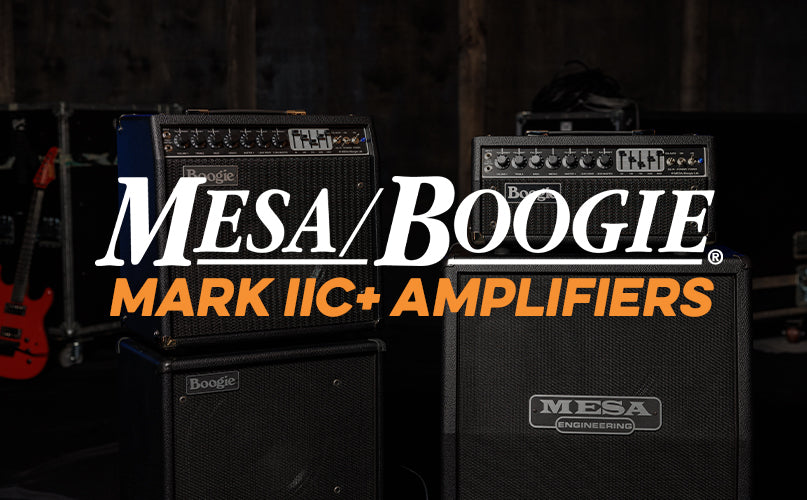INSIDE: MULE RESONATORS
Building a career is a lot like building a guitar. In the words of Mule Resonators’ Matt Eich, it takes “a thousand tiny steps."
You start with a big idea and make it smaller, reduce it into pieces, each a manageable task you finish and build on, and then you put it all together. If you’re lucky, what you have is something even greater than what you expected.
And that’s exactly how it worked for Matt Eich, just in reverse. Eich worked in factories for ten years learning lutherie, tools, tricks of the trade, and all the tiny pieces, and walked out with a big idea: to build resonator guitars designed for acoustic players. The only problem? He’d have to discover how to do it.
Matt Eich takes us through his story and how each success–and each failure–that came with starting over would bring him one step closer to something you can’t build: real joy.

“It's not about the guitar–it's big, fun, human stories.”
Q&A WITH MATT EICH

What is Mule Resonators?
Mule Resophonic is a four-person steel resonator guitar shop in Saginaw, Michigan. Will Shea is our fret and setup precision assassin and comic relief. Denis Costa is our bodybuilder and 1st-place beard contest finisher. Mike Sanders is our resident Black Label Society aficionado and makes all the parts, and I, Matt Eich, steer the row boat and carve necks.
How did you get started building resonators?
I started out at Roberto Venn in 2003, and after some wandering around different blue collar factory jobs started working at Huss and Dalton Guitars in Staunton, VA. Mark, Jeff and the crew taught me what I know and I'm so grateful for their patience and generosity. I carved around 500 necks with Jeff and made all the parts. I was able to get my hands on a lot of really great instruments and see what was required to run a successful business.
When and how did Mule Resonators begin?
After Huss and Dalton I moved closer to some family in Chicago and started another stint of factory work. After a few years I lost my job during the recession. I wrote some songs and toured a bit while I was trying to figure out what came next. What came next was Kelly Joe Phelps and his resonator at a concert in Traverse City. He played slide in a really unique way and the metal guitar made the crowd crazy. He made a joke about the reflection off the chrome blinding the audience. I left wondering if I could make a metal resonator guitar that looked more like the material it was made from, and one with a warm, more acoustic guitar-like sound. I knew how to build instruments but had never even cut or welded a piece of metal. I didn't even know the questions to ask, let alone how to find the answers. I would call metalworking guys and I would get answers like, “I don't know...we don't build guitars." It was a lot of trying everything and throwing a lot of things away and googling. Failure was the path forward. And beer.
What inspired you to begin and what inspires you continue?
I started making them because I thought resonators are a really inspirational type of guitar that were really only being used in blues music. But every player should have a resonator around to wake up some creativity and new sounds. The reason we make steel resonator guitars is for that moment when a player picks it up and strums it and thinks, "Sweet goodness almighty, this is fun...and what the heck do I do with it?”
What comes after is inspiration. What am I hearing? What sounds good? Who plays these and what do they do with it? The guitar is so different it changes players musical choices. Songs come out that maybe wouldn't have otherwise. It isn’t “overwound or underwound” or an “indian vs madagascar” difference. Seeing guys like Ariel Posen or Jeffrey Foucault light up and try new things, or seeing Charlie Parr bring the Pabst Theatre to its feet…it’s so motivating. There’s probably a German word that doesn’t translate well into English to describe it, but I just want to use a lot of exclamation marks.

How would you describe a Mule resonator to someone new to the brand?
They are resonator guitars for acoustic guitar players. They aren't strictly blues-machines. They aren't "set up for slide" and uncomfortable to play. You can play them in standard or open tunings. Slide or not. They sound warm and full and reverby. The sound is a bit like coffee–there's a learning curve and once you learn what you're hearing you're hooked. Then you hear your other guitars in new ways. The inspiration goes around and around.
How is a Mule resonator constructed from start to finish?
Just like any guitar, it's a thousand tiny steps. You make wood and metal smaller, hopefully not too small, and if you do you start over. The guitars look great, but the story behind them is four guys trying hard to make something awesome for people. It's difficult. The struggle makes the positive experiences rewarding.
What components, designs, techniques etc. make Mule Resonators unique?
To make a new-sounding resonator we had to think about it a new way, and that way is thinking of it more like an acoustic guitar. Historically there has been an emphasis in getting the cones moving in resonators, but we try to get the back moving as much as possible. It contributes to the warm and sweet sound people hear. We also build tricone instruments but in a "single cone" body with F-holes. That was the way the first National was made. I like the simpler look of it, but it also contributes a very sweet, vibrant sound that sounds especially good when played with bare fingers.
The patina keeps things looking natural. It's not "mojo" and it's not "worn.” We keep steel looking like steel, use a finish that keeps the neck feeling like wood, and colorful ebony so that it looks like wood. We use stainless steel instead of the more common and more inexpensive mild steel because it sounds awesome. We used torrefied maple and titanium bars in every neck so you don't have to worry about it. We heavily roll every fingerboard so you can’t feel the edge.
The first two things out of everyone's mouth when they pick up a Mule are, "This is heavy," and "this is the best neck I've ever felt." It's a shape I’ve refined over the last 1,200 necks–it's thick and thin in the right spots and takes the human hand's design into consideration. The subtlety in combining the different standard neck shapes and thickness makes the neck familiar regardless of what players typically like. It feels familiar to everyone. We have our own tuners made that fit the look of the guitar. We have our own pickups. There's no fancy wood or inlay. These instruments are tools and we want to do as much as we can to keep the guitar out of the way. It needs to be inspirational but not a distraction.


What inspires your creative process?
At Huss and Dalton, one of the pieces of advice John Calkin shared with me was, "you need to build what people expect." At the time I was an ambitious 20-year-old building 10-string, fanned-fret acoustic guitars and coming up with a new six string body shape every week. It was part fun and part ego: "I like this and look what I can do." If a maker wants to be part of something much bigger than themselves, namely songs and the experiences and meaning shared in them, you have to build tools that most songwriters would use for that purpose. Build what people expect and direct your influence to the important behind-the-scenes work that makes the instrument useful.
What is the spirit of Mule Resonators?
Guitars are fun, and resonators are A LOT of guitar. But what's happened with these crazy, unusual instruments is that it's become more about the story. Mule players are connecting around the guitars and making great friendships. And it’s all types of players. Doug Wamble plays his reso on stage with Wynton Marsalis. Badass players like Seth Lee Jones and Joey Landreth flew to Mule HQ to jam and we recorded the whole thing and put it on Youtube. Now we are all friends and everyone is in on it. We hung out with Billy Gibbons all night and he took OUR picture and gave us groceries for the road. Jason Momoa (Aquaman) wanted a pink Mulecaster and as a trade I ended up running around a castle in the UK dressed as a red coat so he could kill me as part of his Netflix show, Frontier. I watched Adele sing alongside a Mule on her last tour and customers saw the video and felt [like they were] part of it. I have a collection of wedding photos from wives who surprised their husbands with Mules on their wedding day, and a couple videos of dads playing their Mule to their newborn babies. There's so much real joy. It's not about the guitar–it's big, fun, human stories.
What is Mule Resonator’s mission?
Make a ton of awesome guitars for people to see what happens. Who knows what comes next? That's the fun. Who will become friends? What stories will there be? Keep gear talk and specs and measurements out of the way. Guitar-making has been too intellectual. It leads with the wrong part of your brain. No one picks up a truly fun guitar and wonders what the nut width is or how long the rosewood was aged. Players want to get cool guitars and play them and get inspired and connect with people. Guitar-making needs more of that spirit and less talk about heady gear stuff. We are remaking our website at a huge cost to us that will be like social media for reso players. We want the conversation to be less about us and more about the cool stuff people are doing with the guitars.
Where does Mule Resonators go from here?
Who knows? That is part of the fun. Our steel hollow-body StratoMules and Mulecasters are becoming a thing. Check our videos of Ariel Posen playing his pink one and Doug Wamble at the Woodstock guitar show playing his blue one. The difference in tone and touch is not just an "alder vs ash" comparison, which is really not that obvious. A hollow-body steel guitar really affects musical choices and it will be fun to see where else those guitars go.
Is there anything else you’d like for our customers to know about Mule Resonators?
We just want to thank anyone who's bought a Mule, allowed a loved one to spend their allowance on a weird, metal guitar, and anyone interested in what we are about. I spent ten years in factories trying to figure out how to do what I love for a living. If it wasn't for people buying them my life would be very different and I appreciate it a ton.

The blues is a music of balance. Its sadness is edged with the promise of real joy. Today is a blue day, but today is almost over. And tomorrow, well, that will surely be better.
The resonator is forever tied to the blues, and to this idea. Its metallic twang hangs on air like a distant freight train, or the clang of farm tools, or the ring of pots and pans and all the various alloys that sound through our picture of early rural America, when life was hard and every day was a struggle. But with struggle comes joy. Real joy. It’s a product of the balance and it reveals itself to those who care to look. And also like the blues, it has the power to move us to incredible new expressions, the universal kind that inspire and connect us to one another and, together, to something deeper and more profound entirely.
As Eich says the inspiration “goes around and around,” as we move from struggle to joy and back again, but as long as there are people like him taking the time to preserve and innovate fundamental instruments like the resonator where the real joy stops remains to be seen.
To experience the incredible sonic and inspirational qualities of a genuine, handmade Mule Resonator, please stop into our Lincoln Avenue showroom or shop our selection online here.
SHOP MULE GUITARS
Related Posts
Mesa/Boogie | Mark IIC+ Amplifiers
A Legend Returns! Mesa/Boogie’s Mark IIC+ Amplifiers are back and better than ever. Whether you’re after the iconic Head or the portable 1x12 Combo, these amps deliver the vintage Boogie...
Read moreDownload the CME App
Discover the ultimate shopping experience with the Chicago Music Exchange Mobile App! Explore our unparalleled collection of over 14,000 guitars, amps, synthesizers, drums, microphones, and accessories—all at your fingertips. Stay...
Read moreIntroducing | Hiwatt & WEM Amplifiers
Unleash the sound of rock history with Hiwatt and WEM amplifiers at Chicago Music Exchange! From the bold clarity of Hiwatt, a cornerstone of classic British rock favored by legends...
Read more


